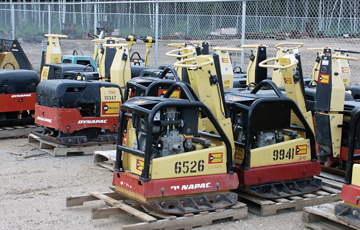 |
   |
Fort McMurray - Canada's "Oildorado" Dynapac Compaction Technology on the World's Largest Construction Site 
Until very recently, the huge Athabasca Oil Sands deposit surrounding Fort McMurray was viewed only as a potential resource. Extracting oil from oil sand was deemed too expensive when compared with traditional oil production. But now, what was once a small fur trading post in North East Alberta has metamorphosed into a boomtown, becoming one of the largest construction sites in the world. Unsurprisingly, this has made it a prime location for all large construction machinery rental companies. The Athabasca Oil Sands are the largest known oil sands in the world. Experts estimate that they contain approximately 1,7-2,5 billion barrels of oil (with one barrel equating to 159 l of crude oil). The only drawback is that it is much more problematic to extract oil here than it is to extract it from the oil fields in the Middle East. At the sands, it is more common to have to open up new deposits by means of expensive seismological investigations or test drills and to perform open cast mining. Once vegetation has been cleared, huge amounts of earth have to be moved and a complex processing procedure is carried out, at the end of which approximately one barrel of crude oil is produced from one cubic meter of sand and loam. Around one million barrels are currently produced in the Fort McMurray region every day. Provided that extraction and processing technologies continue to improve, the Canadian Energy Research Institute (CERI) proposes that three million barrels a day by 2015 is a realistic target. This would make Canada the world's second largest oil exporter after Saudi Arabia. When entering Fort McMurray, visitors are greeted by a modern museum that tells the story of oil extraction at Fort McMurray, from the first large-scale attempts in the 1920s to the complicated process that is carried out today. Photographs and a few vintage showpieces give the visitor a good idea of the sheer scale of the mining equipment used here. "Of course, we can't offer such huge machines to our customers", says Paul Stannard with an apologetic smile, pointing to the yard behind his office building, "but we can provide them with a wide range of construction machinery and equipment". Mr. Stannard has been the Fort McMurray branch manager for United Rentals of Canada Inc. (a rental company with over 700 branches in North America and Canada) for 212 years. Like all well-known construction machinery rental companies, United Rentals has a branch in Fort McMurray, currently employing 37 people. During the short summer period, the yard contains a great deal more oil-fired heating equipment than anything else, whilst the stocks of pumps, compressors, generators and aerial lift devices have dwindled somewhat. "Dynapac vibrating plates are our Number One" Almost 90% of his customers prefer long-term rentals with the possibility of later purchase. Mr. Stannard names some other important details which, besides quality and power, are crucial for his customers: Forward/return motion is controlled via a joystick rather than a bow-type handle and the steel base plates are much more stable than the cast-iron ones used by other suppliers. Dynapac base plates are made from Hardox 400, an extremely wear-resistant steel with a Brinell hardness of 400. He says: "Sand is extremely aggressive. Over the years I've seen many cast-iron base plates that have been completely ground off. With Dynapac, we don't have that problem."
Interest in oil sand did not really take off until the 1990s, when the world market price of oil was rising constantly, thus justifying the comparatively expensive process of mining oil sand. From carpet knives to power shovels Still working at -35°C Bill Brooks goes on to say that in winter -20°C is still quite pleasant, but the difference between -20°C and -40°C is huge and puts great demands on both man and machine. Many of his customers have issued regulations stating that work may not continue at temperatures below -35°C. His many years of experience have taught him that diesel engines are the best option for driving construction machinery and equipment: "Diesel engines meet the strict safety regulations in force on construction sites. Diesel is not as flammable as petrol and thus meets customers' needs and expectations much better. There is one basic rule that applies to all the machines used in and around Fort McMurray: safety first. The working environment is home to all sorts of hidden dangers, which is why all machinery has to be as safe as possible." Hertz puts Dynapac at the top of their list, too Mr. Klatt points to the screen on his desk and explains that each rental center records all data relevant to the machines that have been hired out. This data includes work hours, usage, warranty, repair costs and times, how helpful the manufacturer is, etc. "Only in this way are our records meaningful and we have a complete history of every machine. If we have a component that has failed many times and the manufacturer uses the well-worn phrase, 'You're the first one that this has happened to, we've never had this problem before', that to us is no basis for a close, long-term working relationship." "In this region, Dynapac has grown enormously across all product segments in the last three or four years", confirms Walt Dudnick, Dynapac sales adviser for the region. "Vibrating plates are playing their part in this growth, too. Over 150 machines are in use in Fort McMurray alone. My customers, the rental stores, use machines for three years on average, before replacing them." Oil sand once used by Native Americans to seal their canoes, has now turned Alberta into one of the most prosperous provinces in Canada. |
|
© InfraStructures - Tous droits réservés - All rights reserved |